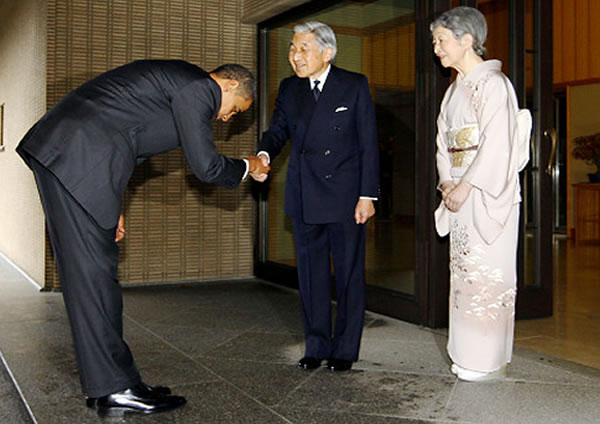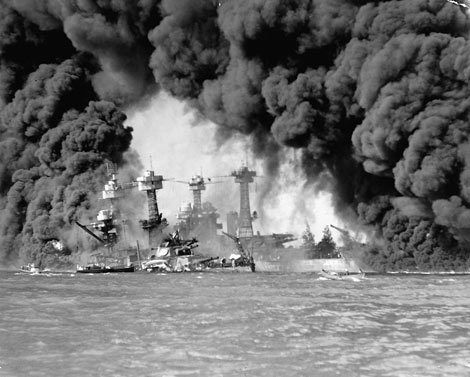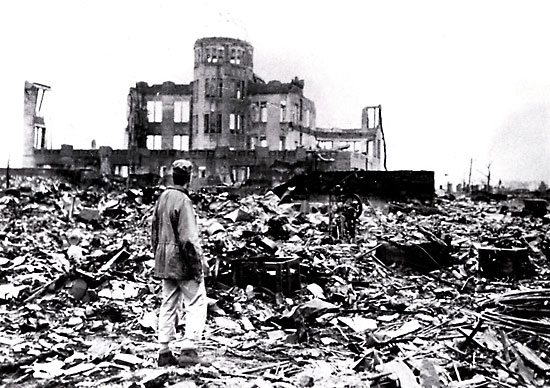Another December 7th has passed "which will live in infamy", but which fewer and fewer Americans actually seem to notice. What lingers, however, especially for many older and conservative Americans, is a searing bitterness toward the Japanese, exemplified by the furious reaction to President Obama's bow to Japan's Emperor Akihito several weeks ago.  I personally don't believe in bowing to anyone, but the President's gesture (though apparently executed wrongly) was respectful in the context of 2009. But its the grainy newsreel images from December 7th, 1941 of hundreds of Japanese dive bombers filling the sky above Hawaii that are repeated over and over again in the minds of those who think about Pearl Harbor at all. The memory of 2,402 people wiped out in the unannounced attack on the U.S. Pacific fleet is not something that's easy to shake off nor should it be.
I personally don't believe in bowing to anyone, but the President's gesture (though apparently executed wrongly) was respectful in the context of 2009. But its the grainy newsreel images from December 7th, 1941 of hundreds of Japanese dive bombers filling the sky above Hawaii that are repeated over and over again in the minds of those who think about Pearl Harbor at all. The memory of 2,402 people wiped out in the unannounced attack on the U.S. Pacific fleet is not something that's easy to shake off nor should it be.  But it's time for Americans and the Japanese to start readjusting our historical lenses and to look at historic tragedies from multiple perspectives to mitigate our natural reflexes toward revisionism.
But it's time for Americans and the Japanese to start readjusting our historical lenses and to look at historic tragedies from multiple perspectives to mitigate our natural reflexes toward revisionism.
We both celebrate and rightly lament the beginning of the war in the Pacific at Pearl Harbor. The Japanese silently mark the end of Japanese military expansionism, which collapsed even prior to Hiroshima: a city reduced to burning embers and molten rock by the heat, radiation, and shock from the world's first atomic bomb attack on Aug. 6, 1945.  Deaths over a period of hours, weeks, and months exceeded 140,000. Three days later, on Aug. 9, a potentially deadlier bomb composed of plutonium 239 exploded over Nagasaki, killing more than 80,000 people.
Deaths over a period of hours, weeks, and months exceeded 140,000. Three days later, on Aug. 9, a potentially deadlier bomb composed of plutonium 239 exploded over Nagasaki, killing more than 80,000 people.
Depending on one's interpretation of history, Hiroshima is either a metaphor for mass murder or the straw that broke the back of the Japanese military and ended the war in Asia and the Pacific.
Today Hiroshima is completely rebuilt, a modern metropolis of skyscrapers and art museums. All that remains from the dark days of 1945 is the skeleton of the old Industrial Promotion Hall. Now known as the Atom-Bomb Dome, it stands lifeless and naked on the edge of the Montayasu River, directly across from Hiroshima's Peace Memorial Park. Hiroshima's Peace Museum, like the Jewish Holocaust Museum or the Vietnam Memorial Wall, was built not only to stir memories but to inspire lessons.
That is why Eileen Moriwake--a Japanese-American teacher from Hawaii whom I interviewed a few years ago--had traveled to Hiroshima several times with some of her middle school students.
"My school is very close to Pearl Harbor, so I see both sides. Unfortunately, my students don't see both sides," Moriwake said. "They have heard the stories about Pearl Harbor, but they haven't heard the stories about Hiroshima."
Since 1968, successive mayors of Hiroshima have campaigned worldwide for peace and against the proliferation of nuclear weapons. Their critics, including some US war historians, belittle "peace education" as little more than an attempt by Japan to play the victim of war and evade responsibility for crimes against humanity. The Japanese have provided critics with ample reasons for this accusation; historical revisionism tops the list.
• To this day, Japan's Ministry of Education continues to publish sanitized versions of the country's role in World War II.
• In 1997, at the request of bomb survivors, the mayor of Nagasaki at that time deleted words of atonement for atrocities committed by the Japanese military from the final draft of a peace declaration on the 52nd anniversary of that city's destruction.
• For years the Japanese government has criticized books detailing "The Rape of Nanking" in which Japanese military men systematically raped, tortured and murdered tens of thousands of Chinese civilians. Japanese officials have not denied that such crimes took place, but take exception to the numbers of victims cited.
It may be that nations and people who have experienced immense suffering are too consumed by their own pain to empathize with the suffering they inflicted on others. It may be naive to believe that the thousands of Japanese schoolchildren who visit the Peace Memorial each year could ever know as much about Pearl Harbor or Japan's human experiments in Manchuria or the mass rape of women throughout Asia --so-called "comfort women"-- as they do about Hiroshima.
The same can be said about education in the United States, which focuses understandably but disproportionately on the loss of life at Pearl Harbor as a direct or implicit justification for the nuclear bombing of Hiroshima. Just think back to 1995, when World War II veterans and their congressional supporters protested a planned exhibit of the Enola Gay (the plane that delivered the A-bomb) at the National Air and Science Museum in Washington. They argued that the exhibit overemphasized the Japanese death toll and did not show the bombing in the proper patriotic perspective. The exhibit was revised, and the museum's curator was forced to resign.
Popular U.S. history tells us that Tokyo refused to quit the war when given the chance. But the US never gave explicit warning to Japan that the A-bomb would be used against it. President Truman - who described the Japanese as "savages, ruthless, merciless, and fanatic" - said his decision to use the bomb on a target surrounded by workers' homes, and without prior warning, would save 1 million American lives. But to this day, there is no evidence that that calculation had any basis in military intelligence.
Some Americans would never subscribe to this argument or historical perspective, for it places on our shoulders far more responsibility than we would like for the deaths ofthousands, and challenges our morality.
A nation's institutional memory is invariably simplistic and achromatic, with good guys in white hats and bad guys in black. But perhaps the real meaning of both Pearl Harbor and Hiroshima is that understanding tragedies of these magnitudes requires casting off our own comfortable interpretations of history, and taking a fresh look based on "new" information that's tempered by the passage of time, and starting anew.